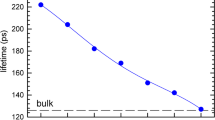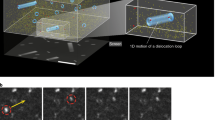Abstract
TDPAC measurements were carried out in tungsten foils and single crystals using implanted111In as a probe nucleus. After damaging the bcc tungsten lattice by heavy ion implantation, electron- and proton-irradiation the trapping of three different defects in the temperature range 293–1,000 K was observed. They were characterized by quadrupole interaction frequencies of v 1 Q = 142(2) MHz, v 2 Q = 181(5) MHz and v 3 Q = 263(5) MHz. The largest fraction of In nuclei experiencing electric field gradients corresponding to v 1 Q and v 2 Q was reached at app. 630 K whereas for v 3 Q this maximum appeared at app. 850 K. The defect configurations producing the different electric field gradients could be identified as a monovacancy trapped in a nearest neighbour 〈111〉 position (v 1 Q ), a double vacancy consisting of two adjacent vacancies in the nearest neighbour shell of the probe atom (v 2 Q ) and possibly a larger cluster (v 3 Q ).
Similar content being viewed by others
References
Rasch, K.D., Siegel, R.W., Schultz, H.: Philos. Mag. A41, 91 (1980)
For a recent review see e.g. Niesen, L.: Hyperfine Interact.9, 619 (1980)
For a recent review see e.g. Kaufmann, E.N., Vianden, R.: Rev. Mod. Phys.51, 161 (1979)
Steffen, R.M., Alder, K.: In: The electromagnetic interaction in nuclear spectroscopy. Hamilton, W.D. (ed.) Amsterdam: North Holland 1975
Steffen, R.M.: Phys. Rev.103, 116 (1956)
Herzog, P., Freitag, K., Reuschenbach, M., Walitzki, H.: Z. Phys. A—Atoms and Nuclei294, 13 (1980)
Manufacturer: Goodfellow Metals, Cambridge, Great Britain
Manufacturer: Metals Research, Melbourn, Great Britain
Prepared at the Max-Planck-Institut für Metallforschung, Stuttgart, Federal Republic of Germany
Maury, F., Biget, M., Vadja, P., Lucasson, A., Lucasson, P.: Radiat. Eff.38, 53 (1978)
Dausinger, F., Schultz, H.: Phys. Rev. Lett.35, 1773 (1975)
Darken, L.S., Gurry, R.W.: Physical chemistry of metals. New York: McGraw-Hill 1953
Vianden, R., Kaufmann, E.N., Rodgers, J.W.: Phys. Rev. B22, 63 (1980)
Pütz, U.: Thesis, Univ. of Bonn, 1982
Schilling, W.: Hyperfine Interact.4, 636 (1978) and ref. cited therein
Oen, O.S.: ORNL-Report 4897 (1973)
Kugler, H.: Diplomarbeit, Stuttgart (1977)
Jäger, W., Wilkens, M.: Phys. Status Solidi (a)32, 89 (1975)
Reintsema, S.R., Verbiest, E., Odeurs, J., Pattyn, H.: J. Phys. F9, 1511 (1979)
Weidinger, A., Wessner, R., Wichert, Th., Recknagel, E.: Phys. Lett.72A, 369 (1979)
For a review see e.g. Balluffi, R.W.: J. Nucl. Mater.69+70, 240 (1978)
Author information
Authors and Affiliations
Rights and permissions
About this article
Cite this article
Pütz, U., Hoffmann, A., Rudolph, H.J. et al. Vacancy trapping at111In in tungsten. Z. Physik B - Condensed Matter 46, 107–116 (1982). https://doi.org/10.1007/BF01312715
Received:
Issue Date:
DOI: https://doi.org/10.1007/BF01312715




